How do Italians celebrate Christmas and what are their customs?
24. 9. 2024
What will you learn in this article?
- ⭐ The Extended Italian Christmas Season
- ⭐ The Heart of Italian Christmas: The Presepio
- ⭐ Beyond the Presepio Other Festive Traditions
- ⭐ Delicious Christmas Traditions: What’s on the Menu in Italy?
- ⭐ Unwrapping Italian Christmas Traditions: Raffles, Pipers, and Midnight Skiing
- ⭐ Mastering the Art of Panettone
- ⭐ Watch the video below to be sure that you did all the steps well and that you will master the panettone for the first time:
Italy, a nation where nearly 80% of the population identifies as Christian, observes Christmas with a captivating blend of faith, cherished family traditions, and exuberant festivities.
Let’s explore the enchanting world of Christmas in Italy, a country renowned for its rich culture and heartwarming customs.
The Extended Italian Christmas Season
Christmas, undeniably the most beloved and significant Christian holiday in Italy, is traditionally spent in the warmth of extended family gatherings.
The pinnacle of the celebration is December 25th, known as “il giorno di Natale.”
However, the festive Christmas season in Italy spans from December 8th, commemorating the Annunciation of the Virgin Mary, to January 6th, the Feast of the Epiphany.
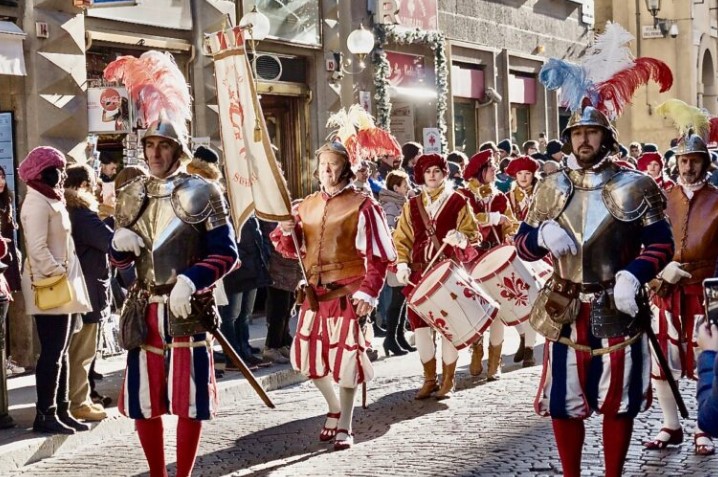
The Heart of Italian Christmas: The Presepio
The Nativity scene, or “presepio,” holds a central place in Italian Christmas traditions. This cherished custom involves creating elaborate miniature scenes depicting the birth of Jesus. These presepi, often handmade with meticulous care, are proudly displayed in homes, churches, and public spaces throughout the country.
A Living Tradition: Unlike the simpler Nativity scenes commonly seen elsewhere, Italian presepi are dynamic and interactive. New figures are added throughout the Christmas season, culminating with the Three Kings’ arrival on January 6th.
From Humble to Humorous: Nativity scenes in Italy range from traditional depictions to whimsical creations featuring contemporary figures like footballers and politicians. The vibrant Christmas Alley in Naples is a testament to this artistic diversity.
Beyond the Presepio Other Festive Traditions
La Befana: The Epiphany on January 6th is celebrated with the arrival of La Befana, a benevolent witch who delivers gifts to children. Christmas Trees: While the presepio is the centerpiece, Christmas trees adorned with lights and ornaments also grace Italian homes during the holiday season.
Festive Feasts: Christmas Eve and Christmas Day are marked by elaborate meals shared with loved ones. Traditional dishes vary by region but often include seafood, pasta, roasted meats, and panettone, a sweet bread studded with candied fruit.
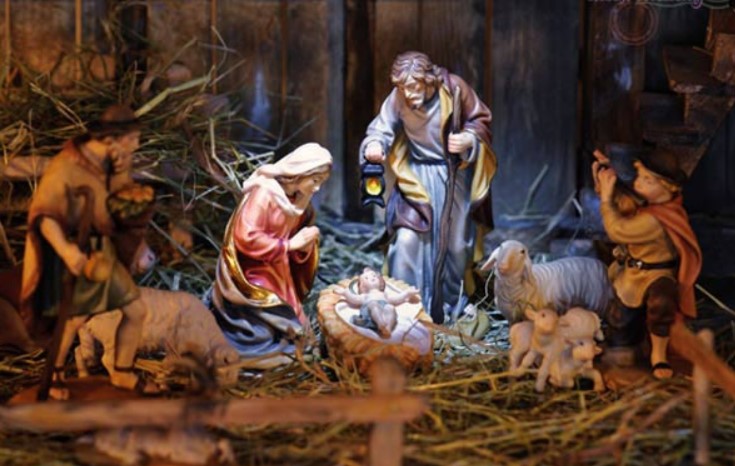
Midnight Mass: Attending Midnight Mass on Christmas Eve is a cherished tradition for many Italian families. The Gift-Givers of Italian Christmas: More Than Just Babbo Natale While Babbo Natale (Father Christmas) certainly holds a special place in the hearts of Italian children, he’s not the only one spreading Christmas cheer. The holiday season in Italy is filled with a delightful cast of characters who bring joy and gifts to children throughout December and into the new year.
La Befana: The Gift-Bearing Witch Perhaps the most unique of these figures is La Befana, a kindly old witch who soars through the night sky on her broomstick, delivering treats to good children and lumps of coal to the naughty ones. Her arrival on the eve of the Epiphany (January 6th) marks the grand finale of the Italian Christmas season.
How are Christmas holidays celebrated in the oldest republic in the world? Come and discover together the unique magic of Christmas in San Marino.
- The Legend: The story of La Befana intertwines with the journey of the Three Wise Men. According to the tale, she was invited to join them on their quest to find baby Jesus, but she declined, only to regret her decision later. She now roams the world, leaving gifts for children hoping to find the infant Christ.
- A Sweet Tradition: On the morning of January 6th, children eagerly hang stockings by the fireplace or their windows, hoping to find them filled with candies, toys, and other goodies.
Other Festive Gift-Givers
- San Nicola (Saint Nicholas): In some parts of Northern Italy, San Nicola makes an early appearance on December 6th, leaving small gifts and sweets for children who have been good.
- Santa Lucia (Saint Lucy): In certain regions, December 13th is marked by the feast of Santa Lucia. Like La Befana, she is said to visit homes at night, leaving sweets for well-behaved children.
A Rich Tapestry of Traditions
The multitude of gift-givers in Italian Christmas traditions adds a layer of magic and excitement to the holiday season. Each character brings their unique story and customs, creating a rich tapestry of celebrations that delight children and adults alike.
So, who brings presents to children in Italy? Babbo Natale, La Befana, San Nicola, and Santa Lucia collaborate joyously to ensure that the spirit of giving and generosity permeates the entire Christmas season!

Delicious Christmas Traditions: What’s on the Menu in Italy?
In Italy, Christmas is a time of abundance and tradition, especially when it comes to dining.
Families gather for a festive dinner on December 24th, known as La Vigilia di Natale. The centerpiece of this meal is typically an array of fish, seafood, and crustaceans, reflecting the country’s strong seafood traditions.
After the meal, it’s customary for families to attend midnight mass at their local church or for those in Rome to visit the Vatican for Midnight Mass with the Pope, which interestingly takes place at 10:30 pm, not midnight. For those unable to attend in person, the Mass in St. Peter’s Square is televised, allowing people to participate from home.
On December 25th, a grand multi-course lunch is served, usually consisting of five to six courses, focused on meat dishes and pasta. This meal is a time for the extended family to come together, sharing in the joy of the season. The lunch culminates with the enjoyment of a traditional Christmas pastry, either pandoro or panettone, often accompanied by Turkish honey “torrone”, adding a sweet conclusion to the meal.
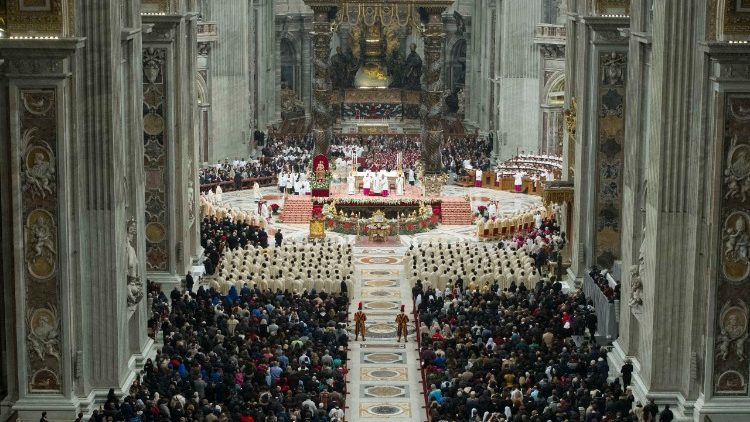
A noteworthy topic during the holiday season is the debate over which Christmas pastry is superior. The main distinction between the two is that classic panettone contains candied fruit, while pandoro does not but is adorned with a dusting of powdered sugar.
This annual debate adds an element of fun and tradition to the holiday celebrations as families and friends enjoy these cherished Christmas delicacies.
Similar articles

Do you know how Christmas is celebrated in Belgium? Learn about Belgian Christmas traditions in our article

How is the traditional French Christmas celebrated? Who is Père Noël and what is Réveillon?

Learn about Bulgarian Christmas customs and bake delicious baklava!

Get to know the magic of Norwegian Christmas and Julenissen the elf. God Jul!
Unwrapping Italian Christmas Traditions: Raffles, Pipers, and Midnight Skiing
In Italy, Christmas traditions vary significantly from region to region, showcasing the country’s diverse cultural tapestry.
While many Italians across the country attend midnight mass on Christmas Day, the northern region, particularly in the Dolomites, has a unique and visually stunning tradition of celebrating the arrival of Christmas. It involves skiing down the snow-covered slopes at midnight with torches, creating a spectacular and enchanting display that is deeply cherished by the local community and visitors alike.
Moreover, in addition to savoring a delightful array of traditional Christmas food, various interactive games play an essential role in the Italian Christmas experience. One such popular game is a unique variation of bingo, where every number corresponds to a specific symbol, adding an extra layer of meaning and excitement to the game.
For instance, 90 is associated with “fear,” and 47 is linked to “dead,” infusing the game with a distinctive and memorable charm that captures the spirit of Italian Christmas celebrations.
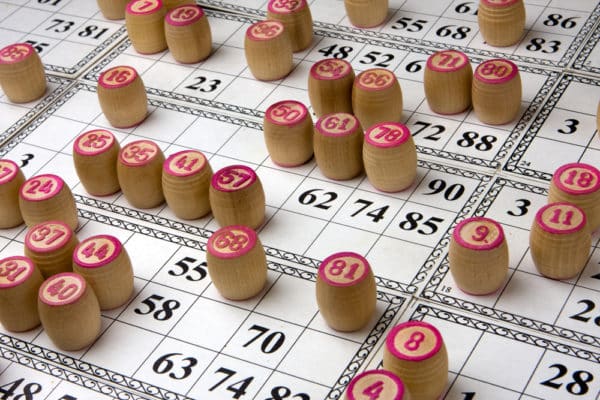
In various Italian cities, especially in Rome, you will encounter men playing the bagpipes in the squares. They are called Zampognari and are dressed like shepherds. This is because, traditionally, the shepherds went from their mountain homes to the square to earn extra money by playing the bagpipes at Christmas. The inspiration comes from the Bible, from the story of the shepherds who visited Jesus on the night of his birth and played the bagpipes for him.
Mastering the Art of Panettone
Christmas in Italy is incomplete without panettone. This delicacy can make your holidays special this year. Its preparation is a bit challenging, but the result is worth it.
The main thing is to be patient and take your time because panettone requires quite a long time to rise. The given recipe is the traditional version, but you can adjust it according to your preferences or possibilities.
Ingredients:
For the first dough
- 2 cups of Italian flour Manitoba (you can use all-purpose flour too)
- 1/2 cup of fresh yeast
- 1 cup of water
- 1/2 cup of soft butter
- 1/2 cup of sugar
- 1/4 cup of egg yolks
- 1 tablespoon of malt
Check out our exclusive Christmas recipes for puff pastry tubes with delicious fillings. You will love this delicious Christmas treat.
For the second dough
- 1/2 cup of Italian flour Manitoba (you can use all-purpose flour too)
- 1/2 cup of of sugar
- 1/2 cup of soft butter
- 5 egg yolks
- 1 cup of raisins
- 1 teaspoon of salt
- 1 vanilla pod
- 3 tablespoons of acacia honey
- 1/4 cup of candied lemon
- 1/4 cup candied orange
- 1/2 cup of orange peel paste
- 1/4 cup of tangerine peel paste
- 3 tablespoons of lemon peel paste
- butter for spreading
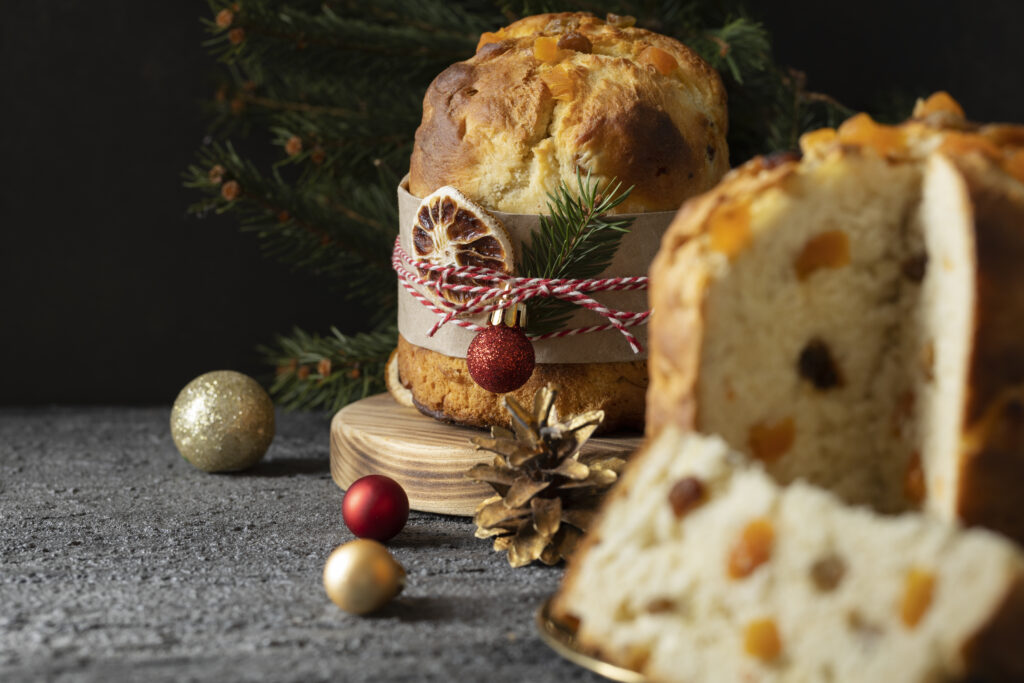
Method:
The first dough
- Start preparing the panettone by preparing the first dough.
- Mix the malt, sugar, and water in a bowl.
- Stir with a whisk until the sugar dissolves, then pour the mixture into a food processor, add the flour, and start kneading.
- Knead for about 5 minutes. Once the dough is firm, add the yeast and continue kneading at a moderate speed.
- Meanwhile, make a cream of butter and egg yolks using a hand whisk.
- Then add the cream in parts to the mixture in the food processor.
- When the dough is smooth and homogeneous, transfer it to the work surface.
- Shape the dough into a ball, wrap it in cling film, and leave it to rise for about 12 hours at room temperature until it has tripled in size.
The second dough
- Remove the first risen dough from the foil and transfer it to a stand mixer fitted with a paddle attachment for the second panettone dough.
- Add the flour and let the machine run at low speed until it is completely absorbed.
- Then, add the orange, tangerine, lemon paste, honey, and seeds from the vanilla pod.
- Run the blender again until the aromas are fully absorbed.
- Meanwhile, prepare the butter and egg yolk cream again.
- Once the dough is elastic, turn off the machine and add the sugar.
- Run the blender again for a few minutes and add a pinch of salt.
- Add the buttercream in two stages, continuing to knead until the dough is well-worked.
- Then add pre-soaked raisins and candied fruit to the dough and mix again.
- When the candied fruit and sultana mixture is well incorporated, turn off the machine and let the dough rest in the bowl for about 20 minutes.
- Then, transfer it to the work surface, fold it a few times, and let it rest at room temperature for another 30 minutes.
Final preparation
- After 30 minutes, shape the dough into a ball and transfer it to a paper muffin tin that is approximately 8.7 inches in diameter and 3.15 inches in height.
- Preheat the oven to 95°F, then turn it off. Cover the panettone with a glass lid and allow it to rise in the oven for 6-8 hours.
- After rising, leave it uncovered at room temperature for about 30 minutes.
- Use a knife to make a cross-cut, and place a small cube of butter in the center of the cross.
- Bake for 50 minutes in a static oven at 347°F.
- Then, remove the panettone from the oven and pierce the outer edges with two steel needles.
- Leave the panettone to cool overnight, and hang upside down with steel pins.
- The next morning, turn it over and remove the needles, and the panettone is ready to be enjoyed.
- Store the panettone tightly sealed in a plastic bag.
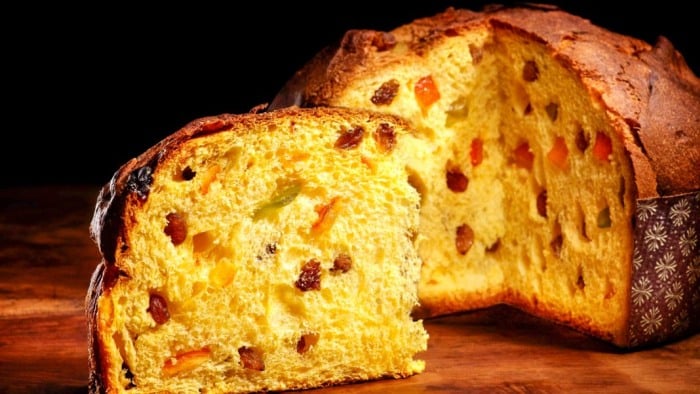
Baking a panettone at home may seem daunting, but with a bit of patience and these tips, you can create this iconic Italian Christmas treat!
- The longer the aromatics sit, the more intense its flavor and aroma. It can also sit for up to 48 hours.
- The longer the biga ferments, the more acidity, flavor, and structure it adds to your dough.
- When you are ready to use it, the biga should double or triple in size and have plenty of fermentation bubbles.
- When ingredients are added to the dough while in the mixer, it will look like nothing is happening for the first 2 to 3 minutes. Be patient and wait a little longer, and the dough will start to come together.
- Place the dough into a cold oven with the door slightly cracked and the oven light turned on to accelerate the proofing times. This will decrease the amount of proofing and fermentation time by about 20%.
- If you notice that the panettone is browning too quickly after 30 minutes of cooking, cover it with foil and turn the heat down to 325° convention for the remaining time
- The dough should not be sticky after each dough is done before proofing or fermenting.
- You will know the dough is good while kneading when the bowl is clean and free from the dough where it is being mixed.
- You rest the dough after fermenting it in the panettone mold so that the dough skin hardens, making it easier to score.
Watch the video below to be sure that you did all the steps well and that you will master the panettone for the first time:
Why not bring a slice of Italy into your home this Christmas?
Baking panettone might take time, but the reward is an exceptional treat that encapsulates the spirit of the season.
With a little practice, you, too, can create this golden, fruit-studded delight and share a piece of Italian tradition with those you hold dear.
Buon Natale e felice anno nuovo!

